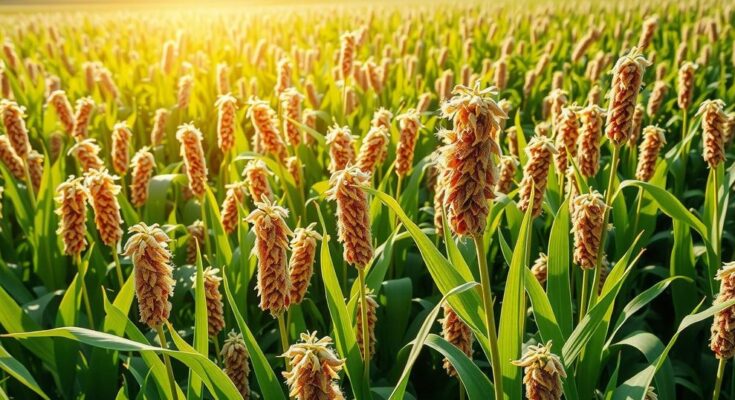Sorghum, an ancient grain, is gaining recognition as a solution to food security issues in Malawi and Africa due to its resilience to climate change, superior nutritional profile, and potential for economic diversification. Experts are advocating for increased awareness and supportive policies to empower farmers and enhance agricultural sustainability.
For many years, African countries have relied heavily on maize as their primary food source. However, as climate change wreaks havoc on agricultural stability, experts are advocating for sorghum as a revolutionary alternative. This resilient and nutritious grain is gaining recognition as a vital component for sustainable agriculture and enhanced food security.
Nate Blum, the CEO of Sorghum United, emphasizes the urgent need to redirect agricultural focus toward sorghum. He articulates, “Sorghum is the future of agriculture,” highlighting its resilience in extreme weather and its numerous benefits for nutrition, soil health, and economic sustainability.
Sorghum demonstrates remarkable adaptability compared to maize, which often succumbs to drought. Blum states, “Sorghum thrives in heat,” explaining its ability to go dormant during dry spells and rejuvenate once moisture is restored. This characteristic positions sorghum as an ideal candidate for areas facing climate challenges.
Another significant benefit of sorghum is its water efficiency; it uses a fraction of the water required by maize—sometimes as little as one-tenth. Blum remarks, “Many parts of the world are battling inconsistent and extreme weather events,” asserting that sorghum and other millets offer practical solutions to global food insecurity and climate issues.
In addition to climate resilience, sorghum is a nutritional powerhouse, providing higher levels of fiber, protein, and essential micronutrients than maize. Its gluten-free nature and low glycemic index further enhance its appeal to health-conscious consumers. Blum mentions, “Sorghum isn’t just food—it’s an opportunity” due to its versatility in various applications, including flour and biodegradable packaging, which can provide farmers with additional income sources.
Despite its advantages, smallholder farmers in Africa face obstacles in adopting sorghum, primarily related to market access and mechanization limitations. Sorghum United is actively working to overcome these challenges through field-to-market trials in several African nations, urging that they “empower local farmers to create their own” sustainable solutions.
Increasing consumer awareness is essential for integrating sorghum into the mainstream market. To aid this effort, Sorghum United is launching educational initiatives aimed at various age groups, including children’s books and video games, while engaging celebrity influencers at major events. Blum states, “We’re even leveraging celebrity influencers at global events like the Oscars.”
As governments explore strategies to bolster food security, it is vital that they encourage policies that support sorghum cultivation. Blum stresses that “public health education on these grains is essential” given the correlation between diet and health issues. By promoting sorghum, there is potential to improve dietary habits and overall well-being.
In a region heavily reliant on maize—often with negative consequences—sorghum emerges as a promising, sustainable alternative. Blum concludes, “This is about more than just a crop; it’s about empowering farmers, protecting the environment, and ensuring a healthier future for generations to come.”
With the right investments, policies, and increased awareness, sorghum has the potential to revolutionize African agriculture and safeguard its future amidst the challenges posed by climate change.
In summary, sorghum presents a viable alternative to maize in addressing food security challenges in Malawi and across Africa. Its resilience to climate change, nutritional advantages, and potential for economic diversification make it an essential crop for future agricultural sustainability. Increasing awareness, improving market access, and fostering supportive policies will be crucial to realizing its full potential and transforming the agricultural landscape in the region.
Original Source: www.nyasatimes.com




